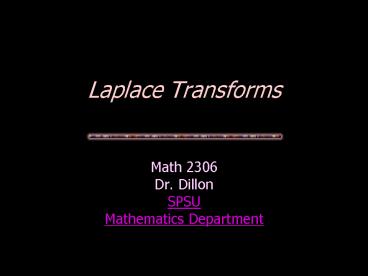Laplace Transforms - PowerPoint PPT Presentation
1 / 37
Title:
Laplace Transforms
Description:
striking a baseball creates a mechanical. impulse. The Dirac Delta Function. This so-called quasi-function was created. by P.A.M. Dirac, the inventor of quantum ... – PowerPoint PPT presentation
Number of Views:50
Avg rating:3.0/5.0
Title: Laplace Transforms
1
Laplace Transforms
- Math 2306
- Dr. Dillon
- SPSU
- Mathematics Department
2
What Are Laplace Transforms?
3
A Laplace transform is a type of integral
transform.
Plug one function in
Get another function out
The new function is in a different domain.
4
Write
5
- A Laplace transform is an example of an improper
integral one of its limits is infinite.
Define
6
A Calculation
Let
This is called the unit step function or the
Heaviside function.
Its handy for describing functions that turn on
and off.
7
1
c
t
The Heaviside Function
8
Calculating the Laplace transform of
the Heaviside function is almost trivial.
then its one.
9
To What End Does One Use Laplace Transforms?
10
We can use Laplace transforms to turn an initial
value problem
Solve for y(t)
into an algebraic problem
Solve for Y(s)
11
Laplace transforms are particularly effective on
differential equations with forcing
functions that are piecewise, like the Heaviside
function, and other functions that turn on and
off.
1
1
t
A sawtooth function
12
I.V.P.
Algebraic Eqn
13
Then What?
14
If you solve the algebraic equation
and find the inverse Laplace transform of the
solution, Y(s), you have the solution to the
I.V.P.
15
Algebraic Expression
Soln. to IVP
16
The inverse Laplace transform of
is
17
Thus
is the solution to the I.V.P.
18
How Do You Transform an Differential Equation?
19
You need several nice properties of Laplace
transforms that may not be readily apparent.
First, Laplace transforms, and inverse transforms,
are linear
for functions f(t), g(t), constant c,
and transforms F(s), G(s).
20
there is a very simple
relationship between the Laplace transform of a
given function and the Laplace transform of that
functions derivative.
Second,
These show when we apply differentiation by parts
to the integral defining the transform.
21
Now we know there are rules that let us determine
the Laplace transform of an initial value
problem, but...
22
How Do You Find Inverse Laplace Transforms?
23
First you must know that Laplace transforms are
one-to-one on continuous functions.
In symbols
when f and g are continuous.
That means that Laplace transforms are
invertible.
24
Inverse Laplace Transforms
25
An inverse Laplace transform is an
improper contour integral, a creature from the
world of complex variables.
Thats why you dont see them naked very often.
You usually just see what they yield, the output.
In practice, Laplace transforms and
inverse Laplace transforms are obtained using
tables and computer algebra systems.
26
Why Use Such Dangerous Machines?
27
Dont use them...
unless you really have to.
28
When Might You Have To?
29
When your forcing function is a
piecewise, periodic function, like the sawtooth
function...
Or when your forcing function is an impulse, like
an electrical surge.
30
Impulse?
An impulse is the effect of a force that acts
over a very short time interval.
A lightning strike creates an electrical impulse.
The force of a major leaguers bat striking a
baseball creates a mechanical impulse.
Engineers and physicists use the Dirac delta
function to model impulses.
31
The Dirac Delta Function
This so-called quasi-function was created by
P.A.M. Dirac, the inventor of quantum mechanics.
People use this thing all the time. You need to
be familiar with it.
32
The Laplace Transform of theDirac Delta Function
33
Beware!
34
Laplace transforms have limited appeal.
You cannot use them to find general solutions to
differential equations.
You cannot use them on initial value
problems with initial conditions different from
Initial conditions at a point other than
zero will not do.
35
Typical Scenario
The charge on a capacitor in an LRC circuit is
given by the following I.V.P.
where the emf, f(t) has the following graph.
36
What Do We Expect You to Be Able to Do?
37
- Know the definition of the Laplace transform
- Know the properties of the Laplace transform
- Know that the inverse Laplace transform is an
improper integral - Know when you should use a Laplace transform on a
differential equation - Know when you should not use a Laplace transform
on a differential equation
38
Be able to solve IVPs using Laplace transforms
When Appropriate































